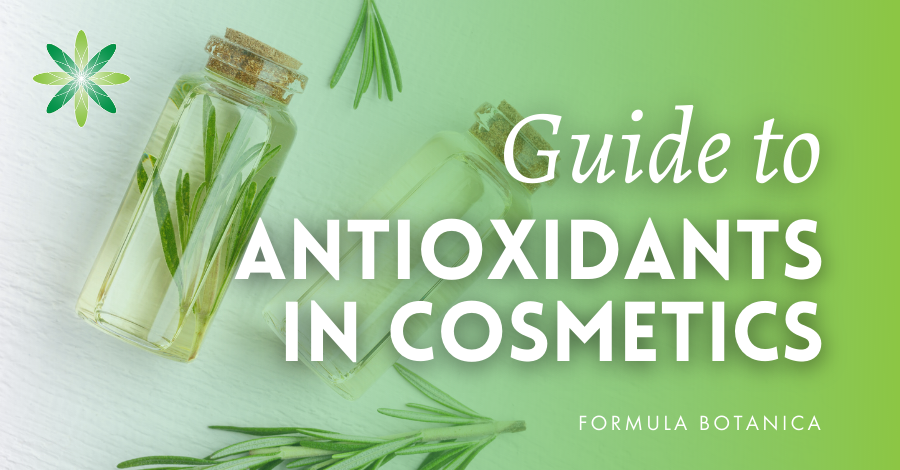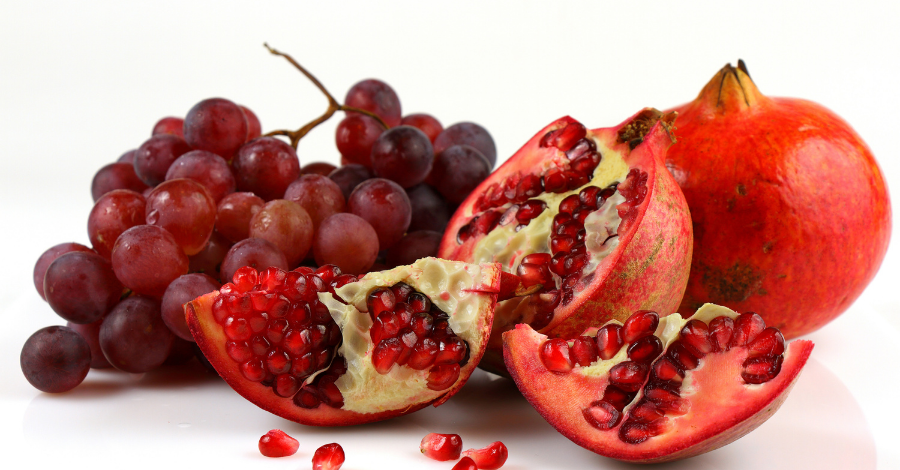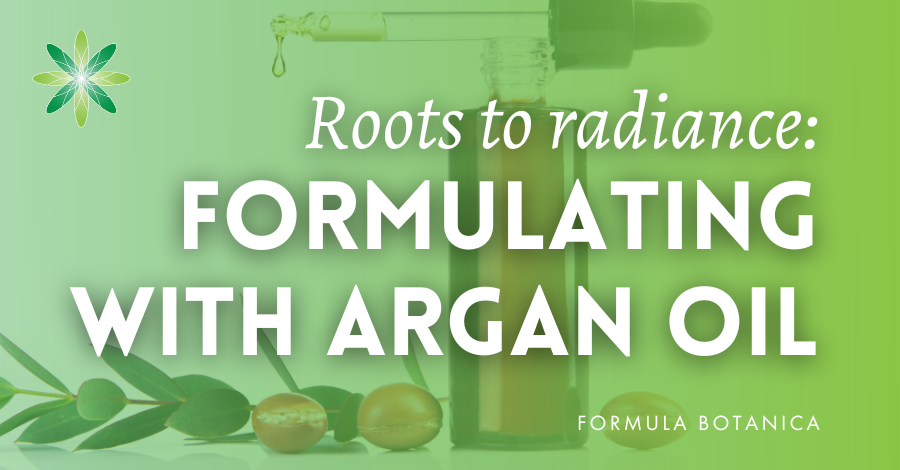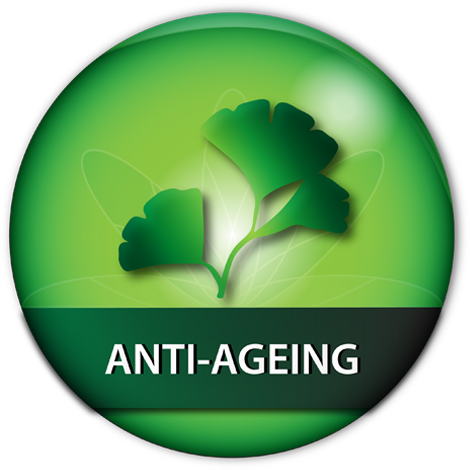Antioxidants have been trending for years, making an appearance in articles and discussions on topics ranging from food to health supplements and skincare. You may have heard them mentioned in relation to skin ageing and alongside free radicals and oxidative stress. But what exactly are antioxidants and what role do they play in cosmetics?
Even if you are new to natural formulation, you are probably already aware that antioxidants help protect your cosmetic products from going rancid, or oxidising. But which antioxidant should you choose and why?
This guide walks you through some key concepts to help you understand what antioxidants are and how they work. You will also learn about how free radicals and oxidative stress are related to skin ageing and how oxidative processes can affect the stability of your cosmetic products. Also, we give you some examples of antioxidant ingredients that you can use easily in your formulations.
First, we tackle the science needed to understand why antioxidants are so valuable as ingredients in our cosmetic products.
Antioxidants and the skin
Free radicals, oxidative stress and ageing
Our skin is a living organ in which many biological processes, such as cellular respiration and vitamin D production, take place. Some of these natural reactions generate free radicals, which are molecules, atoms or ions that have at least one unpaired electron. Because of these unpaired electrons, free radicals are highly unstable and reactive.
In order to become more stable, these molecules need to pair their single electrons. They do this by taking this missing electron from another molecule. This process is called an oxidative reaction. The problem is that now that the second molecule has lost an electron, it becomes a new free radical, thereby creating a chain reaction.
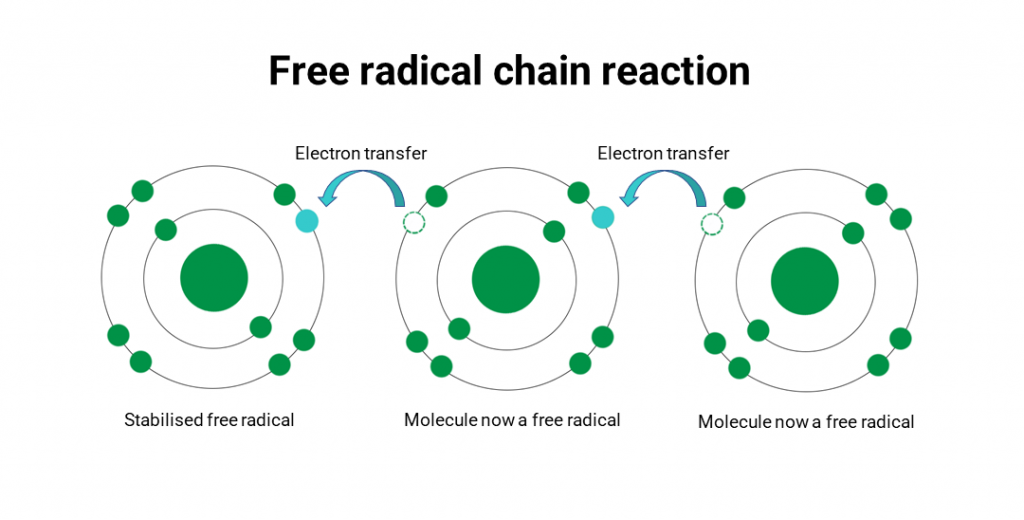
Our bodies can manage the damage caused by these reactions with a complex antioxidant system. Antioxidants are molecules that fight and neutralise free radicals, stopping the oxidative chain reaction before vital compounds are harmed. They protect the cells from oxidative damage and reduce the impact it causes.
Internal factors such as inflammation and external factors such as exposure to pollution, cigarette smoke and UV light can increase the production of ROS and other free radicals. When it exceeds the body’s antioxidant capacity, we have what is called oxidative stress. Also, with age, the production of ROS increases, while the antioxidant production decreases, leading to a progressive imbalance. The deterioration caused by oxidative stress affects the dermal environment in multiple ways, including reducing collagen and elastin production and accelerating the skin’s ageing process.
Using antioxidants to prevent early signs of ageing
As the body’s outermost layer of protection, the skin is constantly exposed to external factors, mainly UV radiation and air pollutants. Oxidative stress then accelerates the ageing process and causes the formation of wrinkles, hyperpigmentation, dryness, and loss of skin tone. The use of cosmetics containing antioxidant actives helps neutralise the formation of free radicals, thereby slowing down the visible signs of ageing.
Some antioxidants used in cosmetics are naturally present in our skin, which is the case of compounds such as vitamin E, vitamin C, and coenzyme Q10, for example. Their topical use helps boost our natural antioxidant protection.
The skin can also benefit from the cosmetic use of some plant extracts that are good sources of natural antioxidant compounds. Plants produce these substances to protect themselves from the sun and other oxidising factors. Recently, interest in plant antioxidants for cosmetic use has grown, with many scientific studies pointing out their benefits. These natural antioxidants can be polyphenols, flavonoids, carotenoids and terpenes, among others.
Plant antioxidants for skincare
As we are natural formulators, we are particularly interested in these plant-extracted antioxidants. Fortunately, many natural antioxidants are available in forms easy for us to include in our cosmetic formulations. Below, we list some you might like to explore to include in your formulations.
Green tea
The extract of the Camellia sinensis leaves contains catechins, a class of polyphenols with remarkable antioxidant properties. In fact, one of these catechins, epigallocatechin gallate (EGCG), is one of the most studied polyphenols. Green tea extracts and EGCG have been shown to reduce the amount of ROS in the skin, diminishing, and even reversing the impact of photoageing and UV damage. Besides that, the topical use of products containing green tea extract can reduce the production of collagen-degrading enzymes in the skin.
Grapes
These fruits are rich in antioxidant compounds. Grape seeds contain proanthocyanidins, which are powerful free radical scavengers. They show more antioxidant activity than vitamin C and E and can even help regenerate these vitamins, presenting synergistic antioxidant activity when combined with them.
Grape skin and red wine also contain resveratrol, a polyphenol with strong antioxidant properties. Based on the most recent studies, it is possible to say it helps protect the skin against oxidative damage caused by free radicals and UV radiation.
Rosemary
The leaves of Rosmarinus officinalis are the source of various antioxidant substances. Most of this activity comes from carnosol and carnosic acid, but ursolic, rosmarinic, and caffeic acids take part in these properties as well, working as free radical scavengers. Rosemary essential oil contains monoterpenes such as 1,8-cineol and alpha-pinene that act as antioxidants too.
Pine bark
Maritime pine (Pinus pinaster) bark extract, also known commercially as pycnogenol, is widely studied for its strong antioxidant properties. It contains phenolic compounds such as proanthocyanidins, which are remarkable antioxidants, regenerating and protecting vitamin C and E from oxidation. Also, this extract has some phenolic acids, such as caffeic and ferulic acids, which are potent free radical scavengers. Some studies suggest that this extract can help slow down the appearance of ageing signs, even reducing hyperpigmentation.
Pomegranate
The fruit and rind of Punica granatum are rich in ellagic acid, a polyphenolic compound that enhances the activity of antioxidant enzymes present in our skin. Pomegranate extract also helps reduce hyperpigmentation and protects the skin against UV damage.
Antioxidants and cosmetic formulations
In addition to the components of our skin, some cosmetic ingredients are also prone to oxidation caused by heat, light, metal ions and oxygen exposure. One of the main causes of shelf-life reduction in cosmetics is the oxidation of unsaturated vegetable oils.
Unsaturated oils have double bonds between the carbon atoms of their fatty acids. A bond between two atoms means they are sharing a pair of electrons. In a single bond, they share only one pair of electrons, while in a double bond, they share two. With more electrons, a double bond is more reactive and unstable.
A double bond can easily lose electrons to an electron acceptor, which is what happens in an oxidative reaction. When we say that unsaturated oils are more prone to oxidation, this is what we are talking about.
Oxidation, or rancidity, can cause discoloration, an unpleasant odour, and even physical instability of the product. The higher the unsaturated content of an oil, the more sensitive it is to heat and oxidation, and the lower its shelf-life.
Read more about unsaturated vegetable oils in our:
Chemist’s guide to checking plant oils for heat sensitivity.
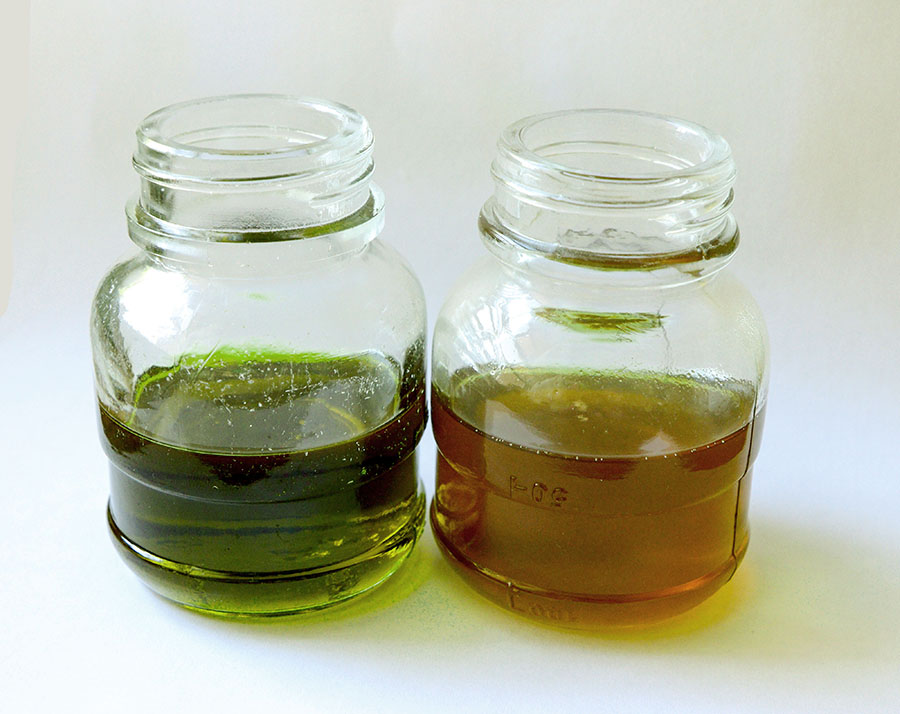
Fresh (left) vs oxidised hemp seed oil.
Not only vegetable oils can oxidise, but other ingredients such as essential oils can pass through oxidation reactions as well. When this happens, the ingredient may also lose its properties. For example, chamazulene, one of the active compounds of blue chamomile essential oil, oxidises easily and in doing so turns from a bright blue to a greenish colour.
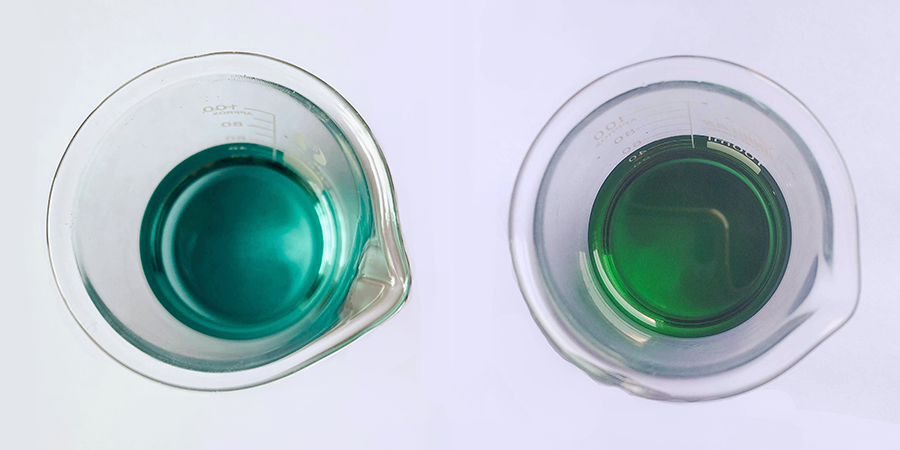
On the left: blue chamomile essential oil diluted in fractionated coconut oil. On the right: the same mixture, now oxidised.
Cosmetic formulations need to be stored in proper conditions to avoid oxidation and rancidity. It is critical to consider the optimal cosmetic packaging you will need when formulating any cosmetic product that contains ingredients prone to oxidation. Options like amber or Miron glass can help protect against light exposure, and airless-pump bottles will reduce the products exposure to air.
The inclusion of antioxidants in a formulation is still the main approach to avoiding the oxidation of cosmetic products. Antioxidants fight the free radicals that cause oxidative damage to your ingredients. Primary antioxidants scavenge free radicals to slow down the oxidation process, while secondary antioxidants act indirectly by other mechanisms, such as binding to metal ions, for example. Secondary antioxidants are more effective when combined with primary antioxidants.
Natural antioxidants for cosmetic formulations
Primary antioxidants
Vitamin E
Vitamin E (tocopherol) is an oil-soluble antioxidant that protects oils and butters from rancidity, as well as providing skin benefits. In fact, what we call vitamin E is a large group of eight molecules with a similar structure. From these, alpha-tocopherol is the most biologically active, while gamma-tocopherol is the best option to protect your formulation. Suppliers can provide you with isolated or mixed tocopherols.
Synthetically-derived esters such as tocopheryl acetate are more stable and less prone to degradation. They provide skin benefits but do not protect the formulation itself from oxidation.
Rosemary CO2 extract
Another popular natural antioxidant is the extract of rosemary leaves made by using supercritical carbon dioxide (CO2) as a solvent. Its antioxidant activity is due to its content of carnosic acid and total phenolic diterpenes, which can sequester free radicals, thereby delaying the oxidation of oils and butters. It has excellent antioxidant activity even in low concentrations. However, it can impart a strong colour and scent to the formulation.
Secondary antioxidants
Chelators
Chelating agents bind to metal ions that can initiate the oxidation of lipids in formulations. They are especially useful in formulations with high water activity, such as oil-in-water emulsions, soaps, and shampoos. Some natural options are phytic acid and its salt, sodium phytate, which are strong chelating agents, and citric acid, that has a weak chelating activity. Another natural chelator is gluconic acid and its derivatives, such as sodium gluconate and gluconolactone.
Carotenoids
Carotenoids have the ability to quench singlet oxygen species (highly-reactive free radicals), absorbing their excess energy. Some common carotenoids are beta-carotene, lycopene, and lutein. The strong orange and red colour of these molecules may limit their use in cosmetic formulations though we recommend natural formulators embrace colour in their products. On the bright side, they also provide skin benefits.
In conclusion
As we can see, the use of antioxidants in cosmetics can serve two purposes: protecting the skin; and protecting formulations from the effects of oxidative damage.
By acting to prevent the damage of oxidative stress on the skin, antioxidants can in turn help mitigate the signs of skin ageing, and keep the skin healthy and in good function. There is a wide variety of plant extracts that contain antioxidant compounds that act on the skin. Some of these are well researched and have compelling evidence of their action.
Although there are not as many antioxidant ingredients that can help protect your formulations, vitamin E and rosemary CO2 extract are widely used and their benefits well established. They can be combined with secondary antioxidants to help maximise their action.
If you’d like to explore using antioxidants in a formulation, see our formulation for an antioxidant hair mask.
You can learn more about antioxidants and other high-performance actives such as peptides and AHAs and BHAs in our Certificate in Organic Anti-Ageing Skincare. Our online Certificate in Cosmetic Stability Testing teaches you how to assess the stability of your formulations. Pre-enrol now for our next term time and enjoy our free formulation training course.
Further reading
Articles
ADDOR, F. A. S. Antioxidants in dermatology. Anais Brasileiros de Dermatologia, v. 92, n. 3, p. 356, 2017.
CHEN, J. et al. Oxidative stress in the skin: Impact and related protection. International Journal of Cosmetic Science, v. 43, n. 5, p. 495–509, 2021.
DE MACEDO, L. M. et al. Rosemary (Rosmarinus officinalis L., syn Salvia rosmarinus Spenn.) and its Topical Applications: A Review. Plants, v. 9, n. 5, p. 651, 2020.
HOANG, H. T.; MOON, J. Y.; LEE, Y. C. Natural Antioxidants from Plant Extracts in Skincare Cosmetics: Recent Applications, Challenges and Perspectives. Cosmetics, v. 8, n. 4, p. 106, 2021.
JURENKA, J. Therapeutic applications of pomegranate (Punica granatum L.): a review. Alternative medicine review : a journal of clinical therapeutic, v. 13, n. 2, p. 128–144, 2008.
NIETO, G.; ROS, G.; CASTILLO, J. Antioxidant and Antimicrobial Properties of Rosemary (Rosmarinus officinalis, L.): A Review. Medicines, v. 5, n. 3, p. 98, 2018.
PRASANTH, M. I. et al. A Review of the Role of Green Tea (Camellia sinensis) in Antiphotoaging, Stress Resistance, Neuroprotection, and Autophagy. Nutrients, v. 11, n. 2, p. 474, 2019.
TÜMEN, İ. et al. Research on the antioxidant, wound healing, and anti-inflammatory activities and the phytochemical composition of maritime pine (Pinus pinaster Ait). Journal of ethnopharmacology, v. 211, p. 235–246, 2018. – Abstract only
YOSHIMURA, M. et al. Inhibitory Effect of an Ellagic Acid-Rich Pomegranate Extract on Tyrosinase Activity and Ultraviolet-Induced Pigmentation. Bioscience, Biotechnology, and Biochemistry, v. 69, n. 12, p. 2368–2373, 2005.
Books
ROSEN, M. R. Harry’s Cosmeticology 9th Edition. v. 2, part 4.1.7.2, 2015
Leave us a comment

Beatriz Amaral is the Cosmetic Scientist at Formula Botanica. She writes many of our fantastic formulation blog posts to help drive forward our mission of teaching the world to formulate naturally. Read more about the Formula Botanica team.

